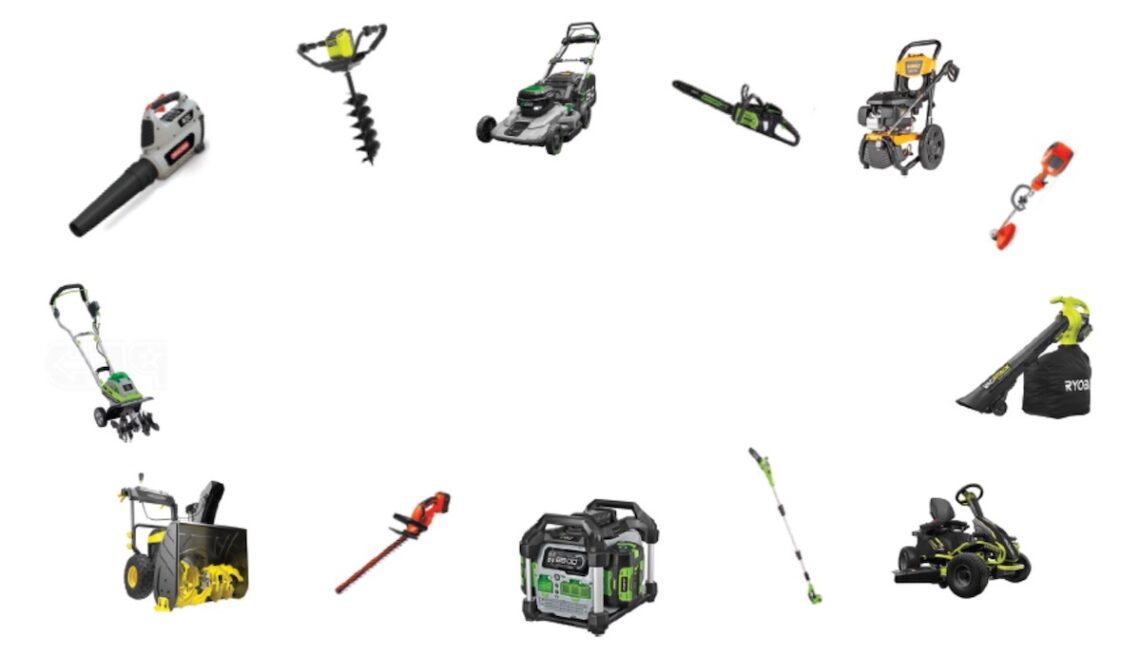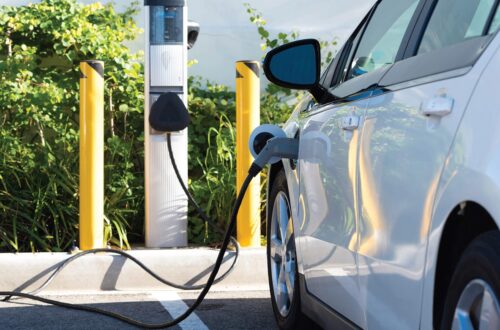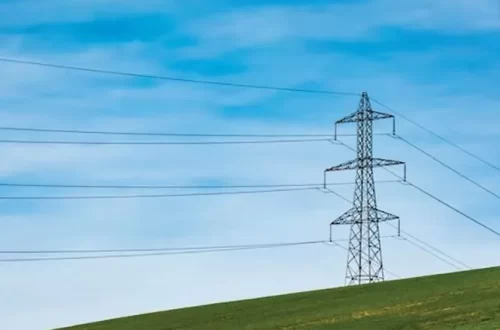About 6 years ago, we ran an article on switching your gasoline-powered lawn and garden tools to all battery-electric versions, and since then, there have been a lot of changes—time for an update.
The first change is in the number of makes and models available today. A Google search for electric yard tools will bring up more than 30 brands, and each brand can have multiple types of tools (lawnmowers, edgers, leaf blowers, etc.), as well as a selection of models for many of the different tools. For instance, walk-behind lawn mowers are available in 14-inch cut to 25-inch cut and as either push or self-propelled.
This range of choices is now similar to what we are used to when shopping for gas-powered tools except for one crucial difference, the way the “fuel” that powers the tool is handled. A simple gas can holds the fuel for the gas-powered tools, and it can pour fuel into any brand of tool. So over time, we end up with multiple brands of tools, a Toro lawnmower, a Troy-Bilt tiller, a Craftsman edger, and so on. Battery electric tools are different because they use electrons for “fuel,” but electrons can’t be contained in anything as simple as a plastic or metal can. So instead, their “gas can” is a battery, and batteries need particular elements and compounds in order to perform the desired chemical reactions that release the electrons that are then “poured” into the tool. This makes them a lot more expensive than the regular gas can.
Also, there are various ways to formulate the battery’s chemistry to increase its power or reduce its cost. The holy grail is the formula that does both, but that has yet to appear on the market. So, different tool manufacturers will use different chemistries to meet their desired performance/cost goals. This means that the battery used to power a Stihl mower is not compatible with the battery used in a Toro mower. The savvy tool brands quickly figured this out and now offer a wide assortment of tools that all use the same interchangeable battery and charger just for their line of tools. Thus, if you buy an Ego lawnmower (with battery and charger) and want to buy a chain saw, the economical choice is to buy one from Ego without the battery or charger. However, if money is no object, one can ignore this and buy different brands of different tools and buy the battery and charger for each.
Decisions, Decisions
If you have decided to go electric as we have, then your first decision is whether or not to go the economical route and buy one brand of tools.
We went for economy and will stick with one brand for our large tools (lawnmower, chain saw, and grass trimmer) and one brand for our smaller tools (grass clippers and hedge trimmer). We did this because the large tool batteries are much larger than the small tool batteries and are not interchangeable even within the same brand. So whether we stick with one brand or go with two, we will need two different batteries and two different chargers.
If you take the economy route, you have to decide what brand of tools you will be buying. With more than 30 choices, this can seem overwhelming at first, but with a bit of thought, the process can be simplified.
Start by making a list of the tools you will want to have, now and in the future. Not all brands make all the tools. For instance, only a few make a snowblower, and even fewer make a hole digging auger.
We made our list, and then we went to several stores (Lowes, Ace, and Home Depot) to check out some of the brands that fit our list (not all brands are available in stores). Next, we decided to base our choice of brands on the lawn mower’s specifications because it will be used more than the other tools we will be buying.
Note: There is a lengthy but informative review of 12 popular brands on YouTube:
We mow about 1/3 of an acre, so we wanted a self-propelled model with as large a cutting blade as we could afford. Also, since our ground is uneven and rough in spots with molehills, we wanted a steel deck.
One of the other tools on our list was an inverter that will allow us to use the mower’s battery to power our desktop computers and LED lights during a power outage. These requirements reduced the number of brands under consideration from 30+ to three. Of the three, only one had a cutting width of 25 inches, and so by elimination, we had our brand because that was the only one with a 25-inch steel deck. Only riding mowers or commercial-grade machines had decks wider than 25 inches but were far too expensive for our pocketbook. Fortunately, the brand that we chose had high reviews from both customers and consumer groups. Unfortunately, the 25-inch model was only available online, so we had to buy it sight unseen.
The larger deck put the price about $100 more than the 21-inch model, and the inverter added another $99, so we decided not to buy any other large tools this year.
If you have more than 1/2 an acre to mow, you are probably interested in a riding mower. They are available, but only a few brands are on the market so far. My search came up with Ryobi, Cub Cadet, Weibang, and Turf One, and prices start around $2,200 for the model with a lead-acid battery. Lithium battery models start around $2,200 and run up to over $4,000.
The next step up is to the commercial-grade of equipment that starts around $7,000 for a Green Works 48-inch Ride On Zero Turn mower and tops out at $35,000 for the top-of-the-line Mean Green EVO-74 model.
And for those who don’t want to mow, there is the robot mower. Pictured is Husqvarna 435X AWD. Other makes and models are available with prices starting at $700
Lake Oswego Goes Electric
The Lake Oswego Sustainability Network newsletter for April 2021 reports that the Lake Oswego City Council approved two 100% electric landscaping contracts covering over 200 public areas in the City. This is a great step towards reducing the hazardous air and noise pollution caused by gas-powered landscaping equipment. In addition, the City has already started purchasing electric landscaping equipment. By actively transitioning to electric equipment, they create a greener and healthier place for the landscaping workers, the community, and the environment.
The newsletter also included testimonials from residents that have switched to electric tools. Here’s what Michael Earp says.
“Works Great While Providing Surprising Resilience:
We have a large lot in the First Addition of Lake Oswego, and although we have reduced the lawn size, it is still a lot to mow. Over the years, I have routinely used electric lawn equipment. At first, cords were standard, which increased the time it took and was a hassle with messing with. I can remember cutting the cord with the mower, too.
I upgraded to a cordless mower when they became available. The first cordless mowers cut down on time spent mowing, but they used a lead-acid battery which made the lawnmower heavier, and the battery had to be recharged halfway through mowing my big lawn.
Today’s electric mowers are very light and have a long runtime with a powerful Lithium battery. It is so quiet and easy to push and can do the entire lot with no problem. There are a number of new Lithium battery-powered mowers available. We use a Ryobi 20 inch 40 Volt cordless mower which comes with a battery charger ($299 at Home Depot).
Ryobi makes a number of attachments and that the same battery can be used on. I have a few of them, including an edger, blower (quiet), portable drill, vacuum, radio, and inverter.
During the last ice storm, I used the 40 Volt Lithium battery from my mower with the inverter to power my house TV for three hours on a charge. And I could have powered the refrigerator.
Once you use one of these new Lithium powered mowers, you will never want to deal with a gas mower again. Skip the hassle with gas tune-ups along with the noise and pollution. Your neighbors will appreciate it, too!”
Cordless yard tools have seen tremendous improvement over the last six years, and yes, there will no doubt be further improvements in the future. The critical point is that for most uses that urban homeowners have for them, today’s models will perform as well as their gas-powered counterparts. And yes, they will cost a little more, but making the switch this season will immediately reduce air and noise pollution in your neighborhood. You’ll save money and never have to deal with a gas can again.
Many thanks to the Lake Oswego Sustainability Network for allowing us to reprint the Michael Earp testimonial and for sharing the news from the Lake Oswego City Council. For more news and info: losn.org






